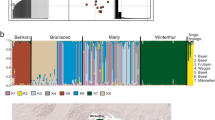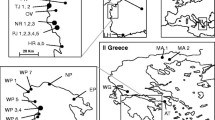Abstract
The green oak leaf roller (Tortrix viridana L.) is a major pest on oaks. The green oak leaf roller is one reason within a disease complex for the oak decline, and it leads to defoliation of oaks in spring. In Germany, Quercus robur L. is mainly affected. The partitioning of genetic variation within and among populations of forest pests is linked to their capacities for migration. And the capacity for migration is the basis for dispersal of the pest species to different host trees and host populations and, therefore, for further outbreak events. Thus, the within population spatial genetic structure (SGS) of T. viridana was investigated based on nuclear (AFLP) markers to analyse the dispersal capacity of this insect pest species at a very small spatial scale. A total of 401 individuals of the green oak leaf roller from four stands in North Rhine-Westphalia (Western Germany) were examined. In three of four populations, the AFLP markers revealed clearly SGS up to 40 m, which can be explained by the mating behaviour within this species.


Similar content being viewed by others
References
Boulesteix M, Weiss M, Biemont C (2006) Differences in genome size between closely related species: the Drosophila melanogaster species subgroup. Mol Biol Evol 23:162–167
Du Merle P (1999) Egg development and diapause: ecophysiological and genetic basis of phenological polymorphism and adaptation to varied hosts in the green oak tortrix, Tortrix viridana L. (Lepidoptera: Tortricidae). J Insect Physiol 45:599–611
Dumolin S, Demesure B, Petit RJ (1995) Inheritance of chloroplast and mitochondrial genomes in pedunculate oak investigated with an efficient PCR method. Theor Appl Genetics 91:1253–1256
Finn DS, Theobald DM, Black WC, Poff NL (2006) Spatial genetic structure and limited dispersal in a Rocky Mountain alpine stream insect. Mol Ecol 15:3553–3566
Food and Agriculture Organization of the United Nations (FAO) 2005. Global Forest Resources Assessment 2005, Republic of Moldova. Country Report 133, Rome, Italy, p 39. Available at: http://www.fao.org/forestry/site/28699/en
Gregorius HR (1978) The concept of genetic diversity and its formal relationship to heterozygosity and genetic distance. Math Biosci 41:253–271
Hardy OJ (2003) Estimation of pairwise relatedness between individuals and characterisation of isolation by distance processes using dominant genetic markers. Mol Ecol 12:1577–1588
Hardy OJ, Vekemans X (2002) SPAGeDi: a versatile computer program to analyse spatial genetic structure at the individual or population levels. Mol Ecol Notes 2:618–620
Hartmann G, Blank R (1992) Winterfrost, Kahlfraß und Prachtkäferbefall als Faktoren im Ursachenkomplex des Eichensterbens in Norddeutschland. Forst Holz 15:443–452
Horstmann K (1984) Untersuchungen zum Massenwechsel des Eichenwicklers, Tortrix viridana L. (Lepidoptera: Tortricidae), in Unterfranken. Zeits Angew Entomol 98:73–95
Hunter MD (1990) Differential susceptibility to variable plant phenology and its role in competition between two insect herbivores on oak. Ecol Entomol 15:401–408
Hunter MD (1992) A variable insect–plant interaction: the relationship between tree budburst phenology and population levels of insect herbivores among trees. Ecol Entomol 16:91–95
Hunter MD (1998) Interactions between Operophtera brumata and Tortrix viridana on oak: new evidence from timeseries analysis. Ecol Entomol 23:168–173
Hunter MD, Varley GC, Gradwell GR (1997) Estimating the relative roles of top-down and bottom-up forces on insect herbivore populations: a classic study revisited. Proc Natl Acad Sci 94:9176–9181
Ivashov AV, Boyko GE, Simchuk AP (2002) The role of host plant phenology in the development of the oak leaf roller moth, Tortrix viridana L. (Lepidoptera: Tortricidae). For Ecol Manage 157:7–14
Jacquemyn H, Brys R, Vandepitte K, Honnay O, Roldan-Ruiz I (2006) Fine-scale genetic structure of life history stages in the food-deceptive orchid Orchis purpurea. Mol Ecol 15:2801–2808
Jiggins CD, Mavárez J, Beltran M, McMillan WO, Johnston JS, Bermingham E (2005) A genetic linkage map of the mimetic butterfly Heliconius melpomene. Genetics 171:557–570
Keyghobadi N, LaPointe D, Fleischer RC, Fonseca DM (2006) Fine-scale population genetic structure of a wildlife disease vector: the southern house mosquito on the island of Hawaii. Mol Ecol 15:3919–3930
Knipple DC, Rosenfiels C-L, Nielsen R, You KM, Jeong SE (2002) Evolution of the integral membrane desaturase gene family in moths and flies. Genetics 162:1737–1752
Liedloff A (1999) Mantel nonparametric test calculator, version 2.00. Queensland University of Technology, Brisbane. URL: http://www.sci.qut.edu.au/NRS/Mantel.htm
Lynch M, Milligan BG (1994) Analysis of population genetic structure with RAPD markers. Mol Ecol 3:91–99
Massonnet B, Weisser WW (2004) Patterns of genetic differentiation between populations of the specialized herbivore Macrosiphoniella tanacetaria (Hompotera, Aphididae). Heredity 93:577–584
Nei M (1987) Molecular evolutionary genetics. Columbia University Press, New York
Nève G, Barascud B, Hughes R, Aubert J, Descimon H, Lebrun PH, Baguette M (1996) Dispersal, colonization power and metapopulation structure in the vulnerable butterfly Proclossiana eunomia (Lepidoptera, Nymphalidae). J Appl Ecol 33:14–22
Nève G, Barascud B, Descimon H, Baguette M (2000) Genetic structure of Proclossiana eunomia populations at the regional scale (Lepidoptera, Nymphalidae). Heredity 84:657–666
Peterson MA, Denno RF (1998) The influence of dispersal and diet breath on patterns of genetic isolation by distance in phytophagous insects. Am Nat 152:438–446
Salvato P, Battisti A, Concato S, Masutti L, Patarnello T, Zane L (2002) Genetic differentiation in the winter pine processionary moth (Thaumetopoea pityocampa–wilkinsoni complex), inferred by AFLP and mitochondrial DNA markers. Mol Ecol 11:2435–2444
Schneider I (1984) Untersuchungen zur Überwachung des Eichenwicklers, Tortrix viridana L. (Lepid., Tortricidae), mit seinem Pheromon. Zeits Angew Entomol 98:474–483
Schneider D (1992) 100 years of pheromone research. Naturwissenschaften 79:241–250
Schneider S, Roessli D, Excoffier L (2000) Arlequin Version 2.000: a software for population genetics data analysis. Genetics and Biometry Laboratory, Department of Anthropology, University of Geneva, Switzerland. http://lgb.unige.ch/arlequin/
Schroeder H, Scholz F (2005) Identification of PCR-RFLP haplotypes for assessing genetic variation in the green oak leaf roller Tortrix viridana L. (Lepidoptera, Tortricidae). Silvae Genet 54:17–24
Schütte F (1957) Untersuchungen über die Populationsdynamik des Eichenwicklers (Tortrix viridana L.). Zeits Angew Entomol 40(1–36):285–331
Simchuk AP, Ivashov AV, Companiytsev VA (1999) Genetic patterns as possible factors causing population cycles in oak leaf roller moth, Tortrix viridana L. For Ecol Manage 113:35–49
Stresemann E, Hannemann HJ, Klausnitzer B, Senglaub K (2000) Exkursionsfauna von Deutschland. Wirbellose: Insekten. Band 2. 9. Auflage, Spektrum Akademischer Verlag, Heidelberg, Berlin, pp 959
Vos P, Hogers R, Bleeker M, Reijans M, van de Lee T, Hornes M, Frijters A, Pot J, Peleman J, Kuiper M, Zabeau M (1995) AFLP: a new technique for DNA fingerprinting. Nucleic Acids Res 23:4407–4414
Wynne IR, Loxdale HD, Brookes CP, Woiwod IP (2003) Genetic structure of fragmented November moth (Lepidoptera, Geometridae) populations in farmland. Biol J Linn Soc 78:467–477
Yela JL, Lawton JH (1997) Insect herbivore loads on native and introduced plants: a preliminary study. Entomol Exp Appl 85:275–279
Zhang D-X, Hewitt GM (1996) Assessment of the universality of a set of conserved mitochondrial COI primers in insects. Insect Mol Biol 6:143–150
Acknowledgments
This project was supported by the “Deutsche Forschungsgemeinschaft” (DFG). We thank Christoph Ziegler and Heinz-Peter Schmitt from the “Landesanstalt für Ökologie, Bodenordnung und Forsten” (LÖBF) for help finding the investigated stands, our technical assistants Susanne Jelkmann, Vivian Kuhlenkamp and Inge Schulze for the laboratory work.
Author information
Authors and Affiliations
Corresponding author
Additional information
Communicated by R. Matyssek.
Rights and permissions
About this article
Cite this article
Schroeder, H., Degen, B. Spatial genetic structure in populations of the green oak leaf roller, Tortrix viridana L. (Lepidoptera, Tortricidae). Eur J Forest Res 127, 447–453 (2008). https://doi.org/10.1007/s10342-008-0228-4
Received:
Revised:
Accepted:
Published:
Issue Date:
DOI: https://doi.org/10.1007/s10342-008-0228-4




